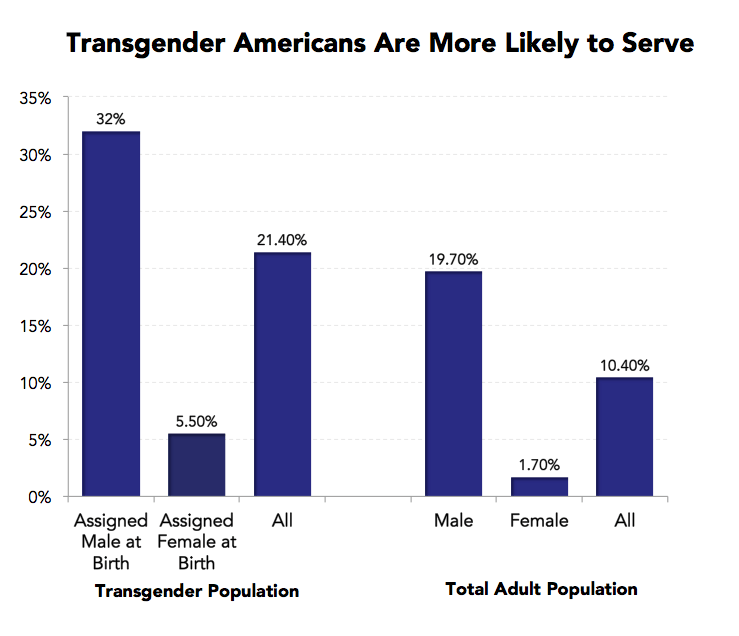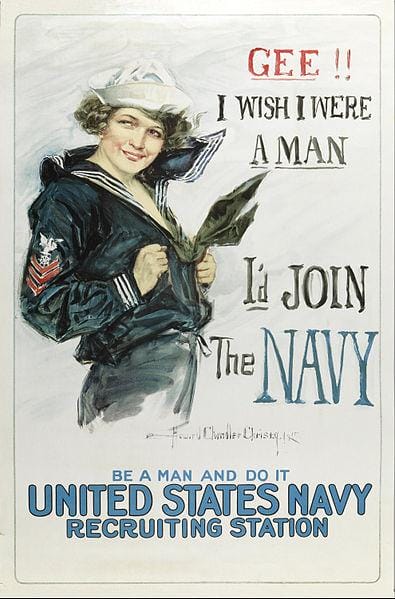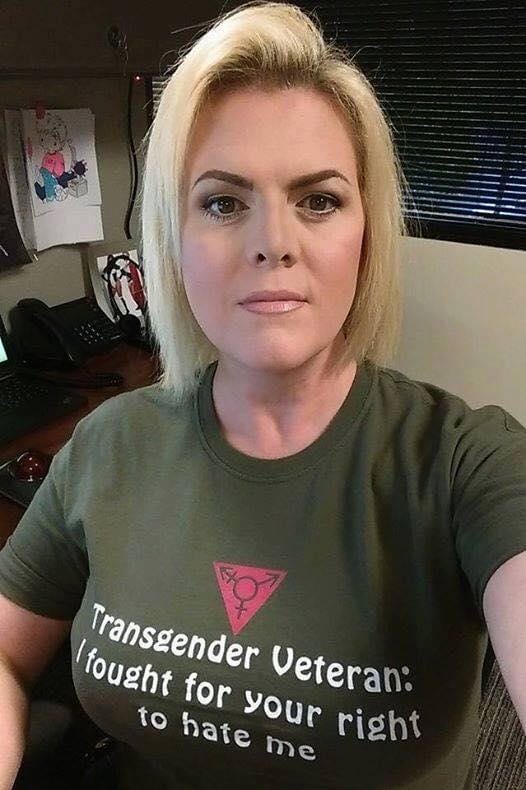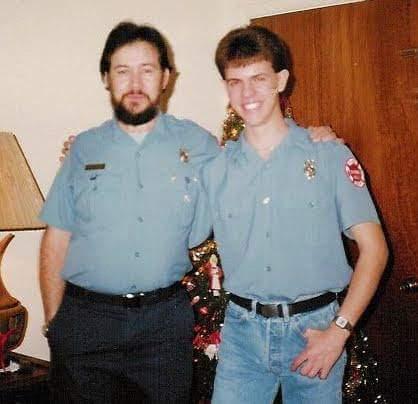Photo from the U.S. Department of Agriculture
***
Why did Lily Kidd join the Marines?
Ask her about it now and she offers a variety of answers. She needed to escape an unaccepting family. She wanted to experience life outside of Alabama. She was eager for a physical challenge (“I don’t go half in on anything,” she says).
But she also joined the United States Marine Corps because, as a twenty-year-old living in the Deep South with a fiancé, Lily Kidd was still presenting herself to the world as a man.
“When you’re growing up as a boy, feminine traits are pushed away,” explains Kidd, a transgender woman who is now 28 and lives in San Diego. “The Marine Corps—that’s the ultimate way to say, ‘hey, you know what, I’ve got nothing to do with that stuff.’”
Last June, the Department of Defense announced that transgender men and women could no longer be discharged from the military on the basis of their gender identity. While the reform arrived too late for Kidd, who was kicked out of the Marines in 2014 after coming out as trans in her seventh year of service, the shift in policy has brought new public attention to the singular challenges (and for many, the very existence) of transgender service members.
But Kidd’s experience is not unique, nor even particularly rare. While media coverage of high profile trans service members like Chelsea Manning and Kristin Beck often presents the stories of transgender troops as novel—a singular juxtaposition of gender nonconformity within institutions that prize conformity above all else—they are anything but.
In fact, the available evidence suggests that transgender Americans serve at rates well above the national average. Though the data is sparse, studies estimate that trans men and women are anywhere from two- to five-times more likely to join the military as their cisgender (nontrans) counterparts. For all its perceived conservatism and raging heteronormativity, the United States Armed Forces is almost certainly the largest employer of transgender people in this country.
Trans service members and veterans offer a variety of explanations for this disparity. For some, the military uniform functions as gender camouflage—a way to forestall uncomfortable questions from friends, family, or spouses. For others, joining the armed forces offers financial security and community to a group that is disproportionately denied both. For Lily Kidd, both aspects motivated her decision to serve.
As both a hiding place and a safety net, the military has become an unlikely refuge for thousands of transgender Americans.
Rough Estimates
You can tell a lot about a society based on the data it collects.
No branch of the United States military gathers statistics about its transgender service members because, up until June of this year, they did not officially exist.
Likewise, estimates of the American transgender population are notoriously unreliable. The U.S. Census Bureau doesn’t ask about transgender identity, though as Mona Chalabi writes at FiveThirtyEight, the results probably wouldn’t be reliable if they did. “Transgender” has no universally agreed upon definition, and many respondents might be reluctant to honestly answer a question about it from a federal agency. The surveys that do exist tend to focus on particular geographic areas or only target the LGBT population.
Still, what rough estimates there are suggest that transgender people are overrepresented in the military. Perhaps dramatically so.
The most prominent of these estimates comes from the Williams Institute, an LGBT-focused think tank based out of UCLA. In a report from 2014, authors Gary Gates and Jody Herman estimate that approximately 15,500 transgender men and women are serving and that an additional 134,300 trans Americans are veterans. Given a national population of 700,000 (another rough estimate), this suggests that over 1-in-5 (or 21.4%) of all openly transgender Americans are in the military or have served at one point.
Compare this to the average adult American service rate of 10.4%. Transgender Americans, in other words, are estimated to be twice as likely to join the military.

“Assigned Male at Birth” refers to trans women along with all gender nonconforming people whose assigned gender at birth was male. Data source: Williams Institute. Chart: Priceonomics
According to the Gates and Herman, the disparity is true of both transgender men and women. Trans people assigned female at birth were estimated to be nearly three times as likely to serve as the average adult woman, while trans people assigned male at birth were 1.6 times as likely to serve as the average man.
The Williams report estimates have been criticized on methodological grounds, so the figures should be taken with a grain of salt. But it does provide one piece of evidence about a larger trend. And there are others.
In 2013, a team of epidemiologists at the Veterans Health Administration published a study on the prevalence of “gender identity disorder” (a classification since abandoned by the American Psychiatric Association) among the millions of veterans within the VHA system.
After poring over hundreds of thousands of health records from between 2000 and 2011, the researchers found that roughly 23 out of every 100,000 patients in the VHA were diagnosed with GID. That is over five times higher than the total population rate of 4.3 per 100,000.
John Blosnich, the lead author on the paper, acknowledges that using GID diagnosis codes is a “very flawed way” to identify transgender vets.
“If you can imagine, a trans person comes into the V.A. or any sort of medical center with a broken arm, there would be a [record] for a broken arm, but there wouldn’t be an ID code for Gender Identity Disorder,” he explains. “So it’s probably an underestimate, if anything.”
Like the estimates provided in the the Williams Institute, the VHA report provides an imprecise statistic. But taken together, they point to the same broader conclusion.
“I think it’s pretty apparent that, yes, trans people are more likely to serve,” says Jake Eleazer, a doctoral student at the University of Louisville who is writing his counseling psychology dissertation on the experience of transgender service members. Eleazer is also a captain in the Kentucky Army National Guard, a board member with the LGBT service member advocacy group, SPART*A, and a transgender man.
“But then it does lead to the question,” says Eleazer. “Why are trans people more likely to serve?”
A Flight to What?
In 1988, George R. Brown, a psychiatrist in the Air Force, published an article in Archives of Sexual Behavior, in which he described his evaluation of eleven “male gender dysphorics” (transgender women) who were then serving, or had recently served, in the military. After reviewing each case, Brown proposed a unifying theory for why trans women might be disproportionately drawn to the armed forces.
A young transgender woman who is trying to deny her gender identity, he wrote, may join the military as a way of “purging his feminine self [sic].”
Or, as the VHA’s John Blosnich paraphrases the argument: “If you’re doubting how ‘manly’ you are, what’s manlier than driving a tank and blowing stuff up?”
In the intervening years, Brown’s “flight to hypermasculinity” theory has become one of the most common explanations for why transgender people might be overrepresented in the military. Extended to both men and women, the simple version goes something like this: transgender women join the military to suppress who they really are, while transgender men do so to express who they really are.
But according to Jake Eleazer, the 31-year-old National Guard captain, that explanation does not square with his experience.
“I think it’s a little bit more nuanced than ‘people are working through their issues,’” he says.
A recruiting advertisement from 1917. Gender has always been “a common theme in the way that we work on bringing folks into the service,” says Jake Eleazer.
Since joining the Guard a decade ago, Eleazer says he kept serving despite his gender identity, not because of it. Over the last ten years, he says he has led a “double life” which, not surprisingly, has made things more difficult, not easier.
The constant need for evasion and the ever present threat of discovery was exhausting, he says. Because he could not talk about his personal life, it was difficult to make or maintain close relationships. When his voice started to drop once he started hormone replacement therapy, he had to chalk it up to a persistent cough until he switched units.
Sometimes his fellow soldiers would use “he,” “his,” and “sir,” befitting his gender identity, while others would say “she,” “her,” and “ma’am,” consistent with his designation within the Army. Eleazer was never quite sure when a correction was in order.
The ambiguity surrounding Eleazer’s gender became a running joke of sorts between him and his fellow drill instructors—although nobody would ever acknowledge the underlying premise of the humor. Whenever a new class of soldiers arrived on base, one would invariably refer to Eleazer as “sir,” at which point the other instructors would swoop in “like you’ve seen in Full Metal Jacket” and give the poor soldier hell for using the “wrong” pronoun.
For all the anxiety and awkwardness, why has Eleazer stuck with the National Guard for a decade? The question takes on new significance for him now as he writes his dissertation asking the same thing of other service members.
Personally, Eleazer says he was drawn to the Guard for the simple reason that he enjoys physical work that gets him outside.
“Maybe you could say that that’s a masculine thing,” he says. “[But] I know plenty of cisgender female soldiers who would roll their eyes at [the] assertion that their military service somehow made them more masculine or more manly.”
Eleazer is finding that, contrary to Brown’s flight to hypermasculinity theory, trans service members join the military for the same reasons that many Americans do. These reasons include financial and health benefits, assistance going to college, and a sense of kinship.
“We see a lot of people who come into the military because they don’t feel like they have a lot of other stable options,” says Eleazer. “[In the military] you know you’re going to have a roof over your head and food in your belly.”
According to the Center for American Progress, anywhere from one- to two-thirds of homeless youth are gay or transgender. A survey from 2009 found that transgender people faced unemployment rates twice the national average. Trans people also report much higher rates of physical and sexual assault and are believed to be ten-times more likely to attempt suicide.
Given all that, says Eleazer, “the idea of joining a community like the military might be very appealing.”
Whether the institution is perceived as “hypermasculine” or not may be beside the point.
An Intolerant Meritocracy
But it wasn’t just material benefits that attracted Staff Sergeant Cathrine Joy Schmid to the army when she was 20 years old.
For Schmid, who is now 32, the military was one of a long list of possible “solutions” that she hoped would rid her of the unshakable, lifelong conviction that she was a woman.
“This is why I got married almost right out of high school, why I tried to go to Bible college, and also why I joined the Army,” she says in an email exchange. Schmid grew up in a deeply religious household where transgender identity was equated with homosexuality and homosexuality with evil.
As George R. Brown wrote in 1988, “the military places a high premium on virility, stoicism, machismo, assertiveness, and all that is, by definition, hypermasculine.” Schmid was drawn to all of this.
“I thought that dedicating myself to God, Country, and good old-fashioned heterosexual romance would make me into the man I was trying so hard to convince myself I was,” she says.
But like religious instruction and marriage, joining the Army failed to have the desired effect. And when it did, she began to consider more dire remedies.
For years afterward, Schmid says she experienced a series of suicidal episodes. The first came in 2008, three years after joining, when Schmid was stationed in Germany with her wife and the first of the two daughters they would have together. (“I thought fatherhood would cure me too,” she says.) After her wife discovered a duffel bag of women’s clothing and makeup that Schmid had secretly stashed away, Schmid says she fell into a deep depression.
“When I found myself staring at my pistol at the firing range, seriously considering pointing it at myself, I realized how bad things really were,” she says.
Things carried on in this way until 2014, when, after returning home from Iraq, Schmid came very close to jumping off a bridge and was hospitalized for three weeks. A month later, she wrote a memo to her commanding officers.
“I have been diagnosed with Gender Dysphoria,” she wrote. “I fully understand the consequences of this diagnosis, that is, that it could be grounds for separation from military service. Again this is not my desire, as fulfilling my military duties and responsibilities are of paramount importance.”
Fortunately for Schmid, her commander agreed. Commanders are often given discretion over which “causes for rejection” are worth acting upon, and Schmid was a capable intelligence analyst.
“The good thing about the Army is that while it may be conservative, intolerant, and restrictive, it’s also the closest thing to a functioning meritocracy that I’ve ever seen,” she says. “And transgender people can do the job.”
Schmid has since transferred to a new unit where her fellow soldiers treat and address her as a woman. In the meantime, she and her wife divorced, though Schmid says she maintains a good relationship with her kids.
And despite joining the “hypermasculine” military as an act of self-deception—one that inevitably failed—she remains loyal to the institution.
“They Don’t Hunt Trans People”
But for many service members, the choice to join the military is not exclusively about denying one’s gender identity or solely motivated by the offer of material and social support.
Both certainly played a role in Lily Kidd’s decision to join the Marine Corps. But the main appeal of serving was that it provided structure and an identity to latch onto until she was in a better position to provide both for herself.
“It wasn’t a conscious thought for me, like ‘oh, I need to get rid of this trans thing,’” she says. “It was like, ‘hey, you know, I could do this for four to eight years, [go to] college, [and] get my life in order.”
Despite the Marine Corps’ inherent conservatism, it also felt like a reasonably safe place to be a confused twenty-year-old. “They don’t hunt trans people,” she says. “Once you’re through the initial bootcamp questioning and stuff like that, they don’t ever ask you again.”
This was often more than could be said of civilian life.
Carla Lewis, a 45 year old trans woman living in Nashville, was also drawn to service for an array of complex reasons that do not fit tidily into one theory or another.
Carla Lewis now works as a software developer in Nashville.
From as early as eight years old, Lewis says she was certain of two things: she wanted to be an astronaut, and she was a woman. Casting her lot with the nerd crowd as a teenager allowed her to pursue the first realization while avoiding the second. Her fondest childhood memory was the weekend she spent at the Marshall Space Flight Center. In high school, she joined the civil air patrol—something akin to the boy scouts for the aeronautically inclined.
At the same time, she says she always felt more comfortable wearing women’s clothing and makeup.
“The only [trans people] that I had ever seen was like on Jerry Springer and Sally Jessy Raphael,” she says. “And I didn’t necessarily think that applied to me.”
Ever the bookworm, Lewis scoured the libraries at her school, in her town, at the local law school. But evidently, there were no books on transgender identity to be found in rural Arkansas in the 1980s.
“For all intents and purposes, I thought that I was the only person like me,” says Lewis.
After struggling in her first year of college, Lewis decided that the U.S. Air Force might be a good place for a misfit with a penchant for rockets.
Like Kidd, Carla Lewis was drawn to the military because it was far easier to call herself an “airman” or a “Marine” than a woman. The service provided an opportunity to postpone a reckoning.
“Condition Not a Disability”
For Lily Kidd, that reckoning came after seven years of distinguished service.
After serving over two years overseas, being promoted to sergeant, and receiving an award for excellence in the field of information and communication technology, Lily Kidd decided to come out as transgender.
She realized that she had to make a change while sitting on a base in Afghanistan.
As she watched fellow Marines lose friends, family members, and spouses to infidelity and the emotional wear and tear of prolonged absence, she was overcome with the sense that life was passing her by.
“I thought, what do I have that I’m holding back?”
Upon returning to Camp Pendleton in southern California, she told her commanding officer that she was trans and asked permission to pursue transition.
As in the case of Cathrine Schmid, Kidd’s commanding officer seemed content to ignore Kidd’s gender as long as her “condition” did not affect her performance. Kidd started hormone replacement therapy. A year and a half passed. But as she began to change physically, Kidd says she lost friends. Other Marines began posting mocking and harassing posts on social media.
“I would go to somewhere on base and everybody was staring at me and taking pictures,” she recalls.
When word finally reached the Sergeant Major of her unit, he gave Kidd the choice to “stop doing this thing” or leave. According to Kidd, this was no choice. The following month, she received a discharge for a “Condition Not a Disability,” a classification that lists “Sexual Gender and Identity Disorders” alongside drug dependence and bedwetting as justifiable reasons for dismissal.
Carla Lewis’ military career was much shorter.
After completing basic training and excelling in technical school, Lewis was shipped off to the White Sand Missile Range in New Mexico. She says she opted for the facility because of its proximity to Roswell, of UFO-sighting lore.
Unfortunately for Lewis, the White Sands placement also required an extensive background check in order to obtain the necessary security clearance. While in training school, Lewis had met with a counselor and discussed her gender identity. Worried that this discussion would come up in the background check, she refused to sign her security clearance application.
Carla Lewis with her father. Prior to coming out, Lewis went by Justin.
Thus ended what Lewis refers to as her “illustrious 16 month career.”
The years that followed their respective discharges were not easy for either Kidd or Lewis.
For months afterward, Kidd says she struggled to get out of bed in the morning. She also struggled to make ends meet or to pay for her hormone doses. She took odd jobs until finally she found work at a satellite communications company. When Defense Secretary Ash Carter announced the change in policy last June, Kidd says she responded with a mix of emotions.
“I’m happy that nobody else has to go through what I went through,” she says. In her former Marine Corps company of nearly 200, Kidd says she can think of five who have since come out as trans. She had not been alone after all.
“But [the policy change] doesn’t do anything for me,” she says. “It’s not going to give me my career back.”
Carla Lewis took much longer to find her place in the world after her discharge.
Though she had to explain the reason for her abrupt departure from the Air Force to her family, (“my father surprised me and said, ‘I wish I had known this, we could have taken you to Las Vegas and you could have become a showgirl,’” says Lewis), she kept her gender identity a secret from everyone else for nearly another decade. In 1999, Lewis’ wife left with the children, and Lewis attempted suicide.
But now, back in school and working as a software developer for a medical technology company in Nashville, Lewis says she has it better than most transgender women in America.
And for all the trauma she experienced as a result of Air Force policy, she says she does not hold a grudge against the institution. When the Department of Defense announced its policy change last June, she says that she was thrilled that so many others could now serve.
“I already knew that there were trans people serving in the closet who were extremely talented, yet they couldn’t be who they really were,” she says. “When you spend your time being told that honesty is a virtue, yet you’re required to lie about something so deeply personal, I feel like you rob the people around you of the gifts that you have to give.”
“Truthfully, if I weren’t too old,” she says, “I would join again.”
Our next article explains how marketers sold America on the white wedding dress by using World War II propaganda. To get notified when we post it → join our email list.
![]()
Announcement: The Priceonomics Content Marketing Conference is on October 27t in San Francisco. Get your early bird ticket now.







